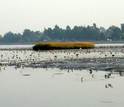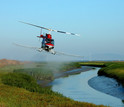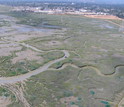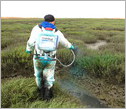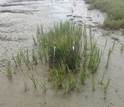News Release 14-071
Eradicating invasive species sometimes threatens endangered ones
Study of California Clapper Rail and salt marsh cordgrass Spartina offers new insights
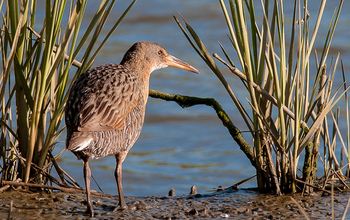
Endangered California Clapper Rail near invasive Spartina along San Francisco Bay.
May 29, 2014
This material is available primarily for archival purposes. Telephone numbers or other contact information may be out of date; please see current contact information at media contacts.
What should resource managers do when the eradication of an invasive species threatens an endangered one?
In results of a study published this week in the journal Science, researchers at the University of California, Davis, examine one such conundrum now taking place in San Francisco Bay.
The study was led by UC Davis researcher Adam Lampert.
"This work advances a framework for cost-effective management solutions to the conflict between removing invasive species and conserving biodiversity," said Alan Tessier, acting deputy division director in the National Science Foundation's (NSF) Directorate for Biological Sciences, which supported the research through NSF's Dynamics of Coupled Natural and Human Systems (CNH) Program.
CNH is also co-funded by NSF's Directorates for Geosciences and Social, Behavioral & Economic Sciences.
"The project exemplifies the goals of the CNH program," says Tessier, "which are to advance the understanding of complex systems involving humans and nature."
The California Clapper Rail--a bird found only in San Francisco Bay--depends on an invasive salt marsh cordgrass, hybrid Spartina, as nesting habitat.
Its native habitat has slowly vanished over recent decades, largely due to urban development and invasion by Spartina.
Study results show that, rather than moving as fast as possible with eradication and restoration plans, the best approach is to slow down the eradication of the invasive species until restoration or natural recovery of the system provides appropriate habitat for the endangered species.
"Just thinking from a single-species standpoint doesn't work," said paper co-author and UC-Davis environmental scientist Alan Hastings.
"The whole management system needs to take longer, and you need to have much more flexibility in the timing of budget expenditures over a longer time-frame."
The scientists combined biological and economic data on Spartina and on the Clapper Rail to develop a modeling framework to balance conflicting management goals, including endangered species recovery and invasive species restoration, given fiscal limitations.
While more threatened and endangered species are becoming dependent on invasive species for habitat and food, examples of the study's specific conflict are relatively rare--for now.
Another case where the eradication of an invasive species threatened to compromise the recovery of an endangered plant or animal is in the southwestern United States, where an effort to eradicate Tamarisk was cancelled because the invasive tree provides nesting habitat for the endangered Southwestern Willow Flycatcher.
"As eradication programs increase in number, we expect this will be a more common conflict in the future," said paper co-author and UC Davis scientist Ted Grosholz.
Other co-authors include scientists James Sanchirico of UC Davis and Sunny Jardine of the University of Delaware.
-NSF-
-
Hybrid Spartina displacing foraging shorebirds on a San Francisco Bay mudflat.
Credit and Larger Version -
Helicopter spraying herbicide to eradicate invasive Spartina in San Francisco Bay.
Credit and Larger Version -
Helicopter view of ongoing eradication program at Cooley Landing along San Francisco Bay.
Credit and Larger Version -
On-the-ground: Backpack-spraying of herbicide to eradicate invasive Spartina.
Credit and Larger Version -
After eradication of invasive Spartina, planting native Spartina for new habitat.
Credit and Larger Version -
The researchers' results are described in the May 30 issue of the journal Science.
Credit and Larger Version
Media Contacts
Cheryl Dybas, NSF, (703) 292-7734, email: cdybas@nsf.gov
Kat Kerlin, UCDavis, (530) 752-7704, email: kekerlin@ucdavis.edu
Related Websites
NSF Grant: CNH: Removal and Restoration: Social, Economic and Ecological Dynamics of Invasive Spartina in San Francisco Bay: http://www.nsf.gov/awardsearch/showAward?AWD_ID=1009957&HistoricalAwards=false
CNH 2013 Grants: National Science Foundation awards $19.4 million for research on coupled natural and human systems: http://www.nsf.gov/news/news_summ.jsp?cntn_id=129178
CNH: Human Disease Leptospirosis Identified in New Species, the Banded Mongoose, in Africa: http://www.nsf.gov/news/news_summ.jsp?cntn_id=127914
CNH: Cooking Up Clean Air in Africa: http://www.nsf.gov/discoveries/disc_summ.jsp?cntn_id=126403&org=NSF
CNH: Studying Nature's Rhythms: Soundscape Ecologists Spawn New Field: http://www.nsf.gov/discoveries/disc_summ.jsp?cntn_id=123046&org=NSF
CNH: Climate of Genghis Khan's ancient time extends long shadow over Asia of today: http://www.nsf.gov/news/news_summ.jsp?cntn_id=130669&org=NSF&from=news
CNH: Summertime: Hot Time in the City: http://www.nsf.gov/discoveries/disc_summ.jsp?cntn_id=128204
The U.S. National Science Foundation propels the nation forward by advancing fundamental research in all fields of science and engineering. NSF supports research and people by providing facilities, instruments and funding to support their ingenuity and sustain the U.S. as a global leader in research and innovation. With a fiscal year 2023 budget of $9.5 billion, NSF funds reach all 50 states through grants to nearly 2,000 colleges, universities and institutions. Each year, NSF receives more than 40,000 competitive proposals and makes about 11,000 new awards. Those awards include support for cooperative research with industry, Arctic and Antarctic research and operations, and U.S. participation in international scientific efforts.
Connect with us online
NSF website: nsf.gov
NSF News: nsf.gov/news
For News Media: nsf.gov/news/newsroom
Statistics: nsf.gov/statistics/
Awards database: nsf.gov/awardsearch/
Follow us on social
Twitter: twitter.com/NSF
Facebook: facebook.com/US.NSF
Instagram: instagram.com/nsfgov

